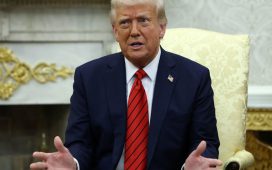Receive free Global Economy updates
We’ll send you a myFT Daily Digest email rounding up the latest Global Economy news every morning.
The worst of the global inflation shock may be behind central bankers as they descend on the Rocky Mountains for the Federal Reserve’s annual gathering this week, but policymakers are wary of declaring victory.
Last year, officials who attended the high-profile event hosted by the Kansas City Fed in Jackson Hole, Wyoming, sought to burnish their inflation-fighting credentials after failing to identify or respond quickly enough to the most acute surge in consumer prices since the 1970s.
But after pushing interest rates up to multi-decade highs, the central bankers in attendance must grapple with another arduous task: fine-tuning policy just right to get inflation under control, without causing undue hardship and job losses.
That they have to do so when the dust is yet to settle on a global pandemic and a war in Ukraine that may have fundamentally rewired the economy makes the challenge more difficult still.
The Fed, European Central Bank and Bank of England are among central banks still sussing out how much more to raise their respective benchmark interest rates, with the impact of past increases yet to take full effect. The spectre of a growth slowdown also looms, while views internally about the outlook have become more fractured. Soon, they too must confront how long to keep those rates elevated to ensure price pressures do not flare up again.
At least in the US, the Fed may be near the end of the rate-rising phase of its inflation battle, having already slowed the pace of tightening as the federal funds rate has crested above 5 per cent. ECB officials are now also toying with a pause, while further increases are expected in the UK this year. But while resilience across the world’s largest economy has damped fears of an imminent recession it has challenged expectations about when the Fed will feel comfortable cutting rates.
“Most of the tightening that they have done was just recovering from an inappropriately loose stance, so only in the last few hikes have they actually brought [rates] into restrictive territory,” said Joseph Gagnon, a former senior staffer at the US central bank. “They’re really in a place where they have to feel their way forward carefully.”
Officials have begun to describe the risks confronting the US economy as “two-sided”, meaning that while their fear of inflation still percolates they are also aware of the costs for consumers and businesses if the monetary screws are tightened excessively. Those concerns have been amplified by China’s economic woes, as well as the continued pullback by US regional lenders in the aftermath of this year’s banking stress.
But even with inflation receding, the manufacturing sector slumping and financial conditions tightening, the labour market — so far — remains strong. Despite monthly jobs growth slowing, the unemployment rate still remains near 50-year lows. That has helped to fuel spending, even as more Americans fall behind on loans and savings stockpiles dwindle.
Raghuram Rajan, a former governor of the Reserve Bank of India, described the recent data as “a little bit problematic”.
“The fact that the labour market is still so strong makes you a little worried that that last mile down to 2 per cent [inflation] may be really prolonged,” he said.
Ellen Meade, who served as a senior adviser to the Fed’s board of governors until 2021, cautioned the central bank against overconfidence about its grip on inflation.
“You don’t want to flip-flop and say we are done and are going to hold for a long time and then find out by the end of the year you have to hike a couple more times,” she said.
Meade also urged the Fed to make clear that once it is done raising rates, its policy will remain “pretty restrictive”.
Former policymakers and economists expect the central bank’s chair Jay Powell to emphasise this “higher-for-longer” stance on interest rates during his much-anticipated speech on Friday.
That approach hinges in part on an assumption that the so-called neutral rate of interest — a level that neither stimulates nor suppresses growth — is higher than in the past.
While the debate is far from resolved, Donald Kohn, who served as the Fed’s vice-chair during the 2008 global financial crisis, thinks loftier borrowing costs are likely to linger.
Ballooning government deficits, increased spending on green energy investments, and heightened focus on domestic manufacturing coupled with stronger-than-expected growth have coalesced to tip the odds against a retreat to the ultra-low interest rates of the post-crisis period, he said.
Fed officials’ own estimates of the neutral rate — also called R-star — have begun to creep up even though the median forecast still hovers at a pre-pandemic level of 2.5 per cent, or 0.5 per cent in real terms, once adjusted for inflation at 2 per cent.
Researchers at the New York Fed surmise that R-star has risen in the short-run, but expect it to fall back to a lower level in the longer term. That is a view also held by the IMF, which warns of secular forces such as ageing demographics again taking over to push down borrowing costs.
Whether or not rates will be permanently higher, Kohn believes a soft landing, in which inflation comes down without a recession, is possible.
Other ex-policymakers are more sceptical. Randall Kroszner, who served as a Fed governor between 2006 and 2009, said he was bracing for a “hardish” landing that could propel the unemployment rate to at least 5 per cent.
“There are very few episodes where you’ve just had a little bit of movement up [in unemployment] as the Fed has tightened,” he said. “It’s not impossible, but that’s a scenario where everything has to go exactly right.”
Kroszner added: “We’re in a world where it’s hard to see everything going right for the next year.”






